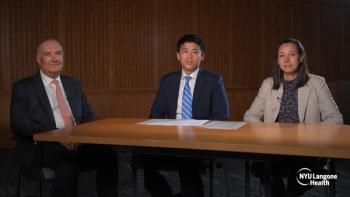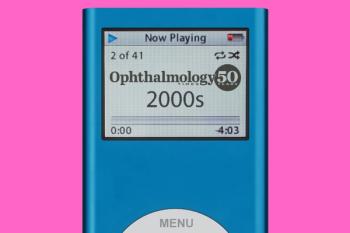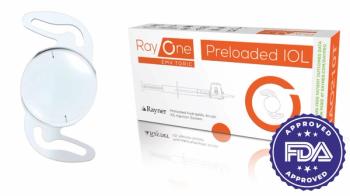
Evolutions in laser technologies making cataract surgery safer
Laser techniques have fundamentally changed the cataract surgery landscape. New, versatile platforms have made surgery safer and provided superior clinical outcomes precisely, consistently and predictably.
Take-home message: Laser techniques have fundamentally changed the cataract surgery landscape. New, versatile platforms have made surgery safer and provided superior clinical outcomes precisely, consistently and predictably.
By Dr H Burkhard Dick
Although femtosecond laser-assisted cataract surgery is now commonplace, using laser to assist with the steps of cataract surgery is still a relatively new concept. The first platforms reached the commercial market only about 5 or 6 years ago. Since then, however, they have undergone remarkable innovations that have served to refine their functionality and performance.
The incorporation of laser cataract surgery (LCS) into regular practice has fundamentally changed how the surgery is done, while also introducing the possibility of performing new techniques. These new techniques have, in turn, made the platforms more versatile and the surgery safer, while also making cataract surgery accessible to populations who may have been previously disqualified.
As important as LCS has been for the cataract surgery field, there are important differences in the platforms available on the market. The individual features of a platform affect how it functions in the operating room: the features interact and complement each other to add to the platform’s overall capabilities.
Rationale and benefits for cataract surgery
I was one of the first surgeons in Europe to start performing LCS on a routine basis, because I believed it was a better way to do the surgery.
For example, a perfectly cut and centred capsulotomy gives a better chance of achieving the IOL’s optimal effective lens position after implantation. Pristine sideport, main, and arcuate incisions offer a means to address astigmatism at the time of surgery and reduce surgically induced astigmatism.
I was also intrigued by the possibility of using the laser to fragment the lens and thereby reduce ultrasound power while potentially lowering the time spent performing intraocular manoeuvres.
As to whether the LCS lived up to my expectations, the short answer is yes. In fact, in my hands, LCS is an upgrade over manual techniques for several reasons.
Although my LCS cases did take a little longer while I was getting used to the new way of operating and figuring out the platform, in the long term, LCS actually improved my surgical efficiency. There is no difference in the time taken for the procedure with LCS (from suction on to wound closure) compared with manual,1 and no difference in cortex removal time.2 The overall procedure time is equivalent to manual because ophthalmic viscosurgical device (OVD) use can be minimised or elimated1 and the need for ultrasound to emulsify the lens is significantly reduced.3
My hunch about the intrastromal incisions also proved correct. Histology studies indicate that laser-cut incisions are precise and accurate, with no apparent damage to the cornea.4 LCS is associated with faster visual rehabilitation, less deviation from the refractive target and earlier postoperative refractive stability than manual surgery.5
Performing LCS may increase prostaglandin levels in the eye, which could induce miosis,6 particularly when cutting the anterior capsulotomy.7
To counteract this and maintain mydriasis, it is highly recommended to use a non-steroidal anti-inflammatory drug three times on the day of surgery.7
However, this is a relatively minor concern, especially considering that LCS does not induce any additional endothelial cell loss8 and can reduce postoperative inflammation compared with manual surgery.9
Platform benefits
When I became interested in adding laser to my cataract surgeries in 2011, I chose the Catalys system (Abbott) because it offered several features I believed would be advantageous for the surgery.
For instance, the the system was introduced with a non-applanating liquid interface that holds the eye firmly in place to minimise eye movement during the procedure. This is important, as respiratory movement of the eye during the capsulotomy step has been suggested as a potential risk factor for capsule tear.10 The liquid optic interface also minimises increases in IOP.11
The system also came equipped with an advanced imaging system, which I foresaw would be important for scanning the eye and preparing the treatment plan.
The accuracy of the imaging would also be crucial for individual capsulotomy centration. Over the years, 3-D spectral-domain optical coherence tomography (OCT) has been added to make the imaging capabilities even stronger.
The system is also extremely fast, with the ability to achieve a full lens fragmentation in less than 30 seconds in most kinds of cataracts. Treatment time may be a little longer in higher-grade cataracts.
However, the laser fragmentation option is much more gentle than the turbulence that would be created by using ultrasound energy to emulsify dense cataracts, and so a slightly longer fragmentation cycle with laser is still preferable over manual techniques in these cases.
These features on their own are important; how they can be used in tandem to complement one another may be even more important.
I have been involved in several research efforts aimed at understanding how the various features can be utilised to optimise patients’ outcomes and facilitate greater efficiency in the operating room. As I have learned, the features can be harnessed to create new surgical techniques that make the surgery safer and easier to perform in routine cases and especially in complex ones.
One example is the ability to perform cataract surgery without the use of OVDs. Because the femtosecond laser can be used to emulsify the lens, which in turn reduces the reliance on ultrasound energy, OVDs may not be necessary to protect the corneal endothelium during the capsulotomy and fragmentation steps.1 An intra-individual comparison of 74 eyes of 37 patients randomised to either standard phaco with OVD or LCS without OVD indicated no difference in endothelial cell loss and a trend toward lower IOP in the group without OVD.12
Another example is to use laser-cut capsulotomies as a rescue technique in cases in which the initial capsulotomy is too small. A case series demonstrated the ability to safely perform phaco and IOL insertion before using laser to enlarge the capsulotomy without causing a capsule tear.13 Such a technique may be applicable and beneficial for eyes in which there is a small anterior capsule opening.
A potential benefit of laser-cut capsulotomies is the ability to achieve an IOL’s effective lens position more rapidly after implantation, thus ensuring faster visual recovery and more predictable outcomes.14
However, while all of the femtosecond laser platforms on the market offer the ability to cut a capsulotomy, the onboard imaging capabilities of the Catalys with regard to its 3-D SC-OCT creates particularly precise positioning.
Another example of complementary functions and their application to cataract surgery is in the ability to perform a posterior capsulotomy. Because this platform’s imaging system can map anterior and posterior capsulotomies, there are several ways to perform a primary posterior capsulotomy with the Catalys, both in adults15 and in paediatric eyes.16 The fluid interface means that it is also possible to first aspirate the cataract then safely re-dock the eye, cut a posterior capsulotomy and perform a bag-in-the-lens implantation.17
Overall, the unique features of Catalys have permitted the expansion of indications for LCS and have made the procedure safe for even complex cases, such as brunescent18 and intumescent white cataracts,19,20 in paediatric patients with Marfan syndrome,21 eyes with a small pupil22 and following trauma cases involving penetrating injury to the cornea and capsule.23
Posterior laser capsulotomy. (Image courtesy of Dr H Burkhard Dick)
Full fragmentation. (Image courtesy of Dr H Burkhard Dick)
Anterior capsulotomy. (Image courtesy of Dr H Burkhard Dick)
Live OCT Intrastromal incision. (Image courtesy of Dr H Burkhard Dick)
The future of cataract surgery
The Catalys system recently underwent a software upgrade to version cOS 3, which served to strengthen the existing functionality while improving workflow.
The biggest upgrade is the addition of streaming OCT, which is of particular benefit to detect eye movement during the incision stage. Aided by an internal guidance system, the cOS 3 upgrade reduces the time needed for incision computation and requires fewer operator adjustments and modifications to the baseline protocols.
The usability of the system with the cOS 3 upgrade is enhanced by the addition of several automated treatment plans, including an option to align the capsulotomy over the scanned capsule using the live OCT feature. The wealth of additions is not overwhelming, however, and the system can be easily integrated for use in all types of cases, from routine to complex. The capsulotomy is performed in less than 1 second with minimal cavitation bubbles and even dense, grade 4 cataracts can be fully fragmented with the laser.
The docking process has also been enhanced in an effort to reduce residual forces during the “lock” step. This feature has implications for reducing micromovements of the eye during the procedure to minimise the risk of capsule tears. These additions add to the already innovative and validated liquid optics interface, which induces minimal changes in IOP and no corneal folds, thereby yielding a clear optical path for laser delivery.
What these upgrades add to an already innovative platform is an increased chance to achieve superior clinical outcomes precisely, consistently and predictably. I have found the cOS 3 upgrade easy to integrate and having it available is a tremendous benefit when I am implanting a premium IOL for which the accuracy of each step is crucial.
When I am able to deliver on the results promised to my patients after surgery, it yields a premium experience, whereby the surgeon can feel satisfied with the result and patients go home happy with their new postsurgical vision.
References
References
1. Dick HB, Gerste RD, Rivera RP, Schultz T. Femtosecond laser-assisted cataract surgery without ophthalmic viscosurgical devices. J Refract Surg 2013; 29: 784–87.
2. Conrad-Hengerer I, Schultz T, Jones JJ, Hengerer FH, Dick HB. Cortex removal after laser cataract surgery and standard phacoemulsification: a critical analysis of 800 consecutive cases. J Refract Surg 2014; 30: 516–20.
3. Dick B, Schultz T. On the way to zero phaco. J Cataract Refract Surg 2013; 39: 1442–44.
4. Schultz T, Tischoff I, Ezeanosike E, Dick HB. Histological sections of corneal incisions in OCT-guided femtosecond laser cataract surgery. J Refract Surg 2013; 29: 863–64.
5. Conrad-Hengerer I, Al Sheikh M, Hengerer FH, Schultz T, Dick HB. Comparison of visual recovery and refractive stability between femtosecond laser-assisted cataract surgery and standard phacoemulsification: six-month follow-up. J Cataract Refract Surg 2015; 41: 1356–64.
6. Schultz T, Joachim SC, Kuehn M, Dick HB. Changes in prostaglandin levels in patients undergoing femtosecond laser-assisted cataract surgery. J Refract Surg 2013 ; 29: 742–47.
7. Schultz T, Joachim SC, Stellbogen M, Dick HB. Prostaglandin release during femtosecond laser-assisted cataract surgery: main inducer. J Refract Surg 2015; 31: 78–81.
8. Conrad-Hengerer I, Al Juburi M, Schultz T, Hengerer FH, Dick HB. Corneal endothelial cell loss and corneal thickness in conventional compared with femtosecond laser-assisted cataract surgery: three-month follow-up. J Cataract Refract Surg 2013; 39: 1307–13.
9. Conrad-Hengerer I, Hengerer FH, Al Juburi M, Schultz T, Dick HB. Femtosecond laser-induced macular changes and anterior segment inflammation in cataract surgery. J Refract Surg 2014; 30: 222–26.
10. Schultz T, Joachim SC, Tischoff I, Dick HB. Histologic evaluation of in vivo femtosecond laser–generated capsulotomies reveals a potential cause for radial capsular tears. Eur J Ophthalmol 2015; 25: 112–18.
11. Schultz T, Conrad-Hengerer I, Hengerer FH, Dick HB. Intraocular pressure variation during femtosecond laser-assisted cataract surgery using a fluid-filled interface. J Cataract Refract Surg 2013; 39: 22–27.
12. Schargus M, Suckert N, Schultz T, Kakkassery V, Dick HB. Femtosecond laser-assisted cataract surgery without OVD: a prospective intraindividual comparison. J Refract Surg 2015; 31: 146–52.
13. Dick HB, Schultz T. Femtosecond laser-assisted capsulotomy rescue for capsulorhexis enlargement. J Cataract Refract Surg 2014; 40: 1588–90.
14. Dick HB, Schultz T. Intraocular lens fixated in the anterior capsulotomy created in the line of sight by a femtosecond laser. J Refract Surg 2014; 30: 198–201.
15. Dick HB, Schultz T. Primary posterior laser-assisted capsulotomy. J Refract Surg 2014; 30: 128–33. doi: 10.3928/1081597X-20140120-09.
16. Dick HB, Schelenz D, Schultz T. Femtosecond laser-assisted pediatric cataract surgery: Bochum formula. J Cataract Refract Surg 2015; 41: 821–26.
17. Dick HB, Canto AP, Culbertson WW, Schultz T. Femtosecond laser-assisted technique for performing bag-in-the-lens intraocular lens implantation. J Cataract Refract Surg 2013; 39: 1286–90.
18. Hatch KM, Schultz T, Talamo JH, Dick HB. Femtosecond laser-assisted compared with standard cataract surgery for removal of advanced cataracts. J Cataract Refract Surg 2015; 41: 1833–38.
19. Conrad-Hengerer I, Hengerer FH, Joachim SC, Schultz T, Dick HB. Femtosecond laser-assisted cataract surgery in intumescent white cataracts. J Cataract Refract Surg 2014; 40: 44–50.
20. Schultz T, Dick HB. Laser-assisted mini-capsulotomy: a new technique for intumescent white cataracts. J Refract Surg 2014; 30: 742–45.
21. Schultz T, Ezeanosike E, Dick HB. Femtosecond laser-assisted cataract surgery in pediatric Marfan syndrome. J Refract Surg 2013; 29: 650–52.
22. Conrad-Hengerer I, Hengerer FH, Schultz T, Dick HB. Femtosecond laser-assisted cataract surgery in eyes with a small pupil. J Cataract Refract Surg 2013; 39: 1314–20.
23. Conrad-Hengerer I, Dick HB, Schultz T, Hengerer FH. Femtosecond laser-assisted capsulotomy after penetrating injury of the cornea and lens capsule. J Cataract Refract Surg 2014; 40: 153–56.
Dr H Burkhard Dick
Dr Dick is chairman of the Ruhr University Eye Hospital in Bochum, Germany. He did not indicate financial interest relevant to the subject matter.
Newsletter
Don’t miss out—get Ophthalmology Times updates on the latest clinical advancements and expert interviews, straight to your inbox.






















































.png)


